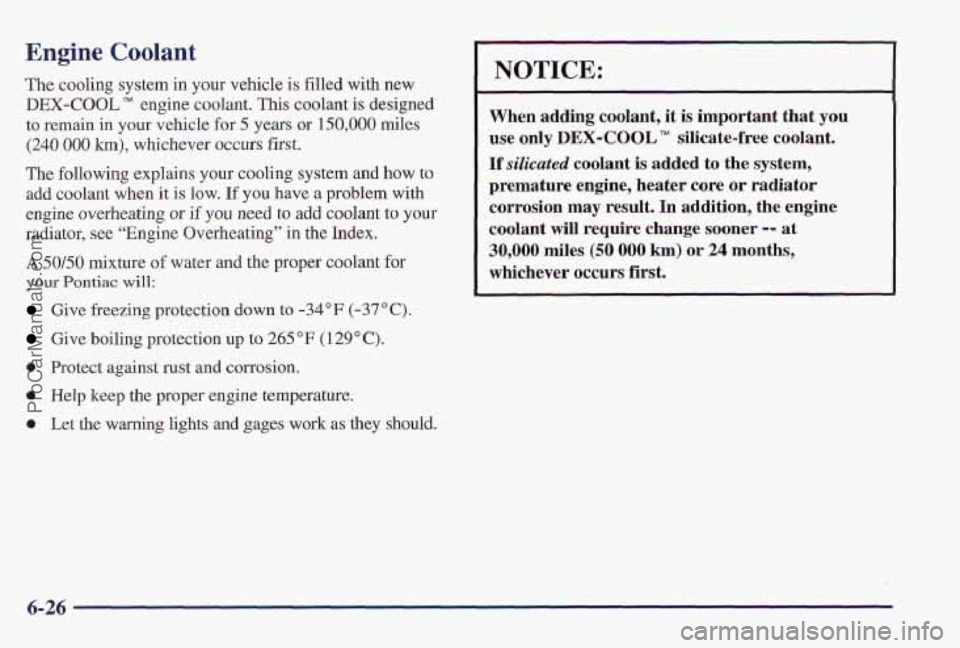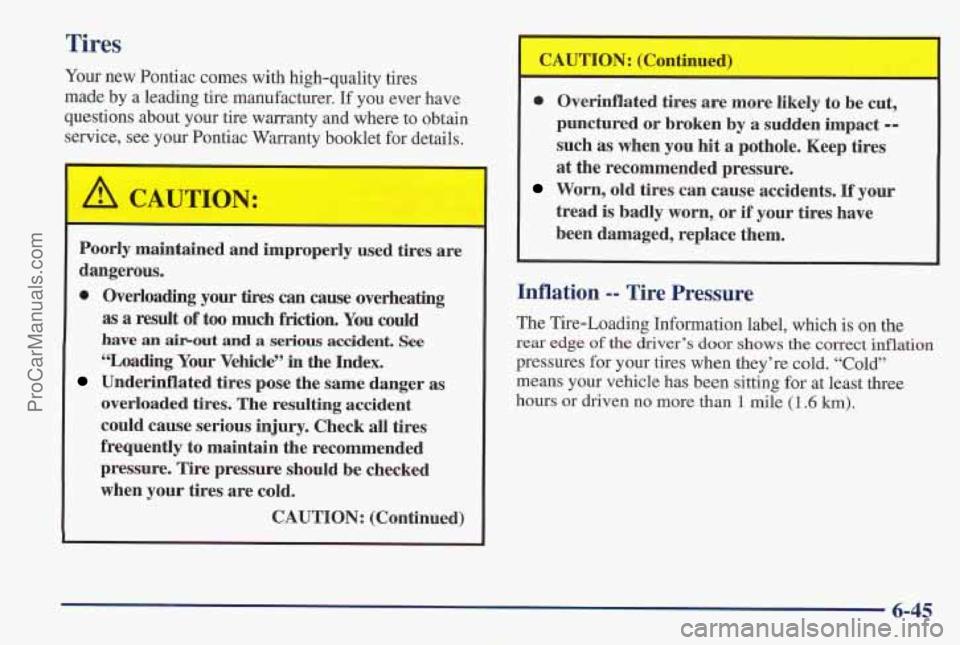1997 PONTIAC PONTIAC heating
[x] Cancel search: heatingPage 235 of 419

Section 5 Problems on the Road
Here you’ll find what to do about some problems that can occur on the road.
5-2
5-2
5-3
5-8
5-9
5-11
5-1 3
5-13
How to Use Warning Flashers
Other Types
of Warning Devices
Step-by-step Procedure for Jump Starting
Information
You Should Know Before Towing
Towing Your Vehicle From the Front
Towing Your Vehicle From the Rear
If Your Engine is Overheating
If Steam is Coming From Your Engine
5- 15
5- 17
5-23
5 -24
5-32
5-34
5-35
5-35 Cooling System
How to
Add Coolant
What to do if
a Tire Goes Flat
How to Change
a Flat Tire
Where to Store the Flat Tire and Tools
Information on the Compact Spare Tire
If You’re Stuck in Sand, Mud,
Snow or on Ice
How to Rock Your Vehicle to Get Unstuck
ProCarManuals.com
Page 247 of 419

Attach a separate safety
chain around the outboard
end
of both lateral arms.
Please take care not to
damage speed sensor
wires or brake
hoses
when attaching chains
l.1 and T-hooks. -
Engine Overheating
You will find a coolant temperature gage and a warning
light about
a hot engine on your instrument panel. See
“Engine Coolant Temperature Gage” and “Engine
Coolant Temperature Warning Light” in the Index.
You
also have a low coolant light on your instrument panel.
Sed‘Low Coolant Light” in the Index.
If Steam Is Coming From Your Engine
Steam from an overheated engine can burn you
badly, even if you just open the hood. Stay away
from the engine if you see or hear steam coming
from it. Just turn it off and get everyone away
from the vehicle until it cools down. Wait until
CAUTION: (Continued)
5-13
ProCarManuals.com
Page 251 of 419

NOTICE:
Engine damage from running your engine
without coolant isn’t covered
by your warranty.
_I
If there seems to be no leak, with the engine on, check to
see if the electric engine fans are running.
If the engine
is overheating and the key
is on, both fans should be
running. If they aren’t, your vehicle needs service.
How to Add Coolant to the Coolant
Recovery Tank
If you haven’t found a problem yet, but the coolant level
isn’t at the
COLD mark, add a 50/50 mixture of clean
water (preferably distilled) and DEX-COOL
antifreeze at the coolant recovery tank. (See “Engine
Coolant” in the Index for more information.)
Adding only plain water to your cooling system
can be dangerous. Plain water, or some other
liquid like alcohol, can boil before the proper
coolant mix will. Your vehicle’s coolant warning
system is set for the proper coolant
mix.
With plain water or the wrong mix, your engine
could get too hot but you wouldn’t get the
overheat warning. Your engine could catch
fire
and you or others could be burned. Use a 50/50
mix of clean water and DEX-COOL antifreeze.
I NOTICE:
In cold weather, water can freeze and crack the
engine, radiator, heater core and other parts.
Use the recommended coolant and the proper
coolant mix.
ProCarManuals.com
Page 296 of 419

The cooling system in your vehicle is filled with new
DEX-COOL TM engine coolant. This coolant is designed
to remain in your vehicle for 5 years or 150,000 miles
‘(240 000 h), whichever occurs first.
The following explains your cooling system and how to
add coolant when it is low. If you have a problem with
engine overheating or if you need to add coolant to your
radiator, see “Engine Overheating” in the Index.
A $OB0 mixture of water and the proper coolant for
your Pontiac will:
Give freezing protection down to -34°F (-37°C).
Give boiling protection up to 265 “F (129’ C).
0 Protect against rust and corrosion.
0 Help keep the proper engine temperature.
0 Let the warning lights and gages work as they should.
I
NOTICE:
When adding coolant, it is important that you
use only IBEX-COOL TM silicate-free coolant.
If silicated coolant is added to the system,
premature
engine, heater core or radiator
corrosion may result. In addition, the engine
coolant
will requipe change sooner -- at
30,000 miles (50 000 km) or 24 months,
whichever occurs first.
6-26
ProCarManuals.com
Page 298 of 419

Checking Coolant
When your engine is cold, the coolant level should be
at the COLD mark or a little higher. To check coolant
level, remove the cap on the coolant recovery bottle and
verify that
the coolant level is up to the COLD fill level
on the hose attached to the cap.
LOW
COOLANT
If this light comes on, it
means
you’re low on
engine coolant.
Adding Coolant
If you need more coolant, add the proper DEX-COOL”
coolant mixture at the mulant recovery tank.
If the coolant recovery tank is completely empty, add
coolant
to the radiator. (See “Engine Overheating” in
the
Index.)
6-28
ProCarManuals.com
Page 299 of 419

Turning the radiator pressure cap when the
engine and radiator
are hot can allow steam
and scalding liquids to blow out and burn
you
badly. With the coolant recovery tank, you will
almost never have to add coolant at the radiator.
Never turn the radiator pressure cap
-- even a
little -- when the engine and radiator are hot.
Add coolant mix at the recovery tank, but be careful not
to spill it.
You can be burned if you spill coolant on hot
engine parts. Coolant contains ethylene glycol,
and it will burn
if the engine parts are hot
enough. Don't spill coolant on a hot engine.
I I
Radiator Pressure Cap
NOTICE:
Your radiator cap is a 15 psi (105 kPa)
pressure-type cap and must be tightly installed to
prevent coolant loss and possible engine damage
from overheating. Be sure the
arrows on the cap
line up with the overflow tube
on the radiator
filler neck.
When you replace your radiator pressure cap, an AC'
cap is recommended.
Thermostat
Engine coolant temperature is controlled by a thermostat
in
the engine coolant system. The thermostat stops the
flow of coolant through the radiator until the coolant
reaches a preset temperature.
When
you replace your thermostat, an AC@thermostat is
recommended.
6-29
ProCarManuals.com
Page 315 of 419

Tires
Your new Pontiac comes with high-quality tires
made by
a leading tire manufacturer. If you ever have
questions about your tire warranty and where to obtain
service, see your Pontiac Warranty booklet for details.
E
Poorly maintained and improperly used tires are
dangerous.
Overloading your
tires can cause overheating
as a result of too much friction. You could
have
an airout and a serious accident. See
“Loading Your Vehicle” in the Index.
Underinflated tires pose the same danger as
overloaded tires. The resulting accident
could cause serious injury. Check all tires
frequently to maintain the recommended
pressure. Tire pressure should be checked
when your tires are cold.
CAUTION: (Continued)
0 Overinflated tires are more likely to be cut,
punctured or broken by a sudden impact
--
such as when you hit a pothole. Keep tires
at the recommended pressure.
Worn, old tires can cause accidents. If your
tread is badly worn,
or if your tires have
been damaged, replace them.
Inflation -- Tire Pressure
The Tire-Loading Information label, which is on the
rear edge of the driver’s door shows the correct inflation
pressures for your tires when they’re cold. “Cold”
means your vehicle has been sitting for at least three
hours or driven
no more than 1 mile (1.6 km).
6-45
ProCarManuals.com
Page 410 of 419

Electrical Equipment. Adding .......... 2-17. 3.30. 6.66
Electrical System
............................... 6-66
Electrochromic Daymight Rearview Mirror
.......... 2-53
Electronic
Climate Control ........................ 3-2
Engine
.............................. 6-9.6-10. 6-11
Coolant
..................................... 6-26
Coolant Heater
............................... 2-18
Coolant Level Check .......................... 7-39
Coolant Temperature Gage
..................... 2-75
Coolant Temperature Light
..................... 2-74
Exhaust
...................... 2-11.2-29.4-28. 4-35 Identification ................................ 6-6 1
Running While
Parked ......................... 2-29
Specifications
........................... 6-72. 6-73
OilLevelCheck
.............................. 7-39
Overheating
................................. 5-13
StartingYour ................................ 2-16
Engineoil
.................................... 6-12
Adding
..................................... 6-14
Additives
6- 18
Checking
................................... 6-14
Used ....................................... 6-19
Whentochange .............................. 6-18 r .
...................................
Ethanol ........................................ 6-4 ~
Exhaust, Engine ................. 2-11,2-29,4-28. 4-35
Exit Lighting
............................. 2-42, 2-45
Fabric Cleaning
............................... 6-56
Fan
Knob. Climate Control System .................. 3-2
Filling Your Tank ................................ 6-5
Fan Button. Automatic and Auxiliary Temp Control ..... 3-6 Filter. Air
..................................... 6-19
Finishcare
.................................... 6-61
Finish Damage ................................. 6-62
First
Gear, Automatic Transaxle ................... 2-22
Fixed Mast Antenna
............................. 3-32
Flashers, Hazard Warning
......................... 5-2
Flat Tire, Changing ............................. 5-24
Fluids and Lubricants
............................ 7-44
Foreign Countries, Fuel
........................... 6-5
Front Reading Lamps ............................ 2-43
Filling Your Tank .............................. 6-5
Gage ....................................... 2-77
In Foreign Countries ........................... 6-5
Fuses
and Circuit Breakers ........ .......... 6-66
................................... Flash to Pass 2-33
FogLamps
.................................... 2-40
French Language Manual 11
FrontTowing ................................... 5-9
Fuel
.......................................... 6-3
Canadian
.................................... 6-3
.. ...........................
d-7
ages Engine Coolant Temperature ....... .......... 2-75
Fuel ....................................... 2-77
GAWR
....................................... 4-30
Gear Positions. Automatic Transaxle ................ 2-19
Gross Axle Weight Rating ........... .......... 4-30
Gross Vehicle Weight Rating ...................... 4-30
GloveBox .................................... 2-54
Guide en Frangais 11 .. .................................
.....................................
GVWR 4-30
9-4
ProCarManuals.com